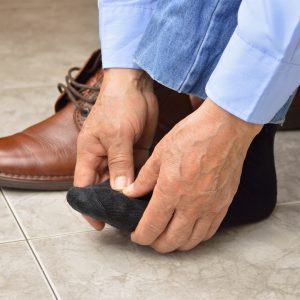How to Choose Orthopedic Shoes (That Are Right for You!)

Which orthopedic shoe is the best shoe for you? That is one of the most frequently asked questions for foot specialists, physical therapists, and other rehab professionals. Why is it such a common question? According to Orlin & Cohen physical therapist Jordan Placella, PT, DPT, GTS, it’s simply because there is no straight answer.
How to Choose Orthopedic Shoes (That Are Right for You!)
Picking out the perfect orthopedic shoes depends on several different factors:
- Foot size and shape
- Arch height
- Gait mechanics (meaning how you walk)
- Medical conditions related to foot posture
Additionally, how you walk significantly impacts the ground reaction force on your feet and can help determine which shoe can be most comfortable—and beneficial.
Depending on your gait pattern, a shoe with a larger or smaller heel height can help to eliminate lasting injuries of the foot, ankle, knee, or even hip. Even the amount of cushion impacts the mechanics of how you walk.
Beyond shoe specifications, there are shoe inserts that can help ease pain or help correct specific deformities of the foot.
Orthopedic Shoe Inserts: Choosing the Right Fit
Familiarize yourself with the different types of inserts and how they work.
Heel lift
A heel lift is a pad placed under the heel to increase the heel height in relation to the front of your foot (also known as the forefoot). A heel lift can be used to decrease load or force in the Achilles tendon. That can be useful if the Achilles tendon is irritated or causing pain—and specifically useful for diagnoses such as Achilles’ tendinitis, plantar fasciitis, or even leg length discrepancy.
Metatarsal pad
A metatarsal pad is a foam/gel-type pad placed under the forefoot or just under the ball of your foot. This is useful for patients with localized pain at the forefoot or pain under the base of the toes. A metatarsal pad is commonly used with diagnoses such as metatarsalgia, Morton’s neuroma, or for people who tend to walk or run with excessive forefoot impact.
Medial or lateral wedge
If you walk with excessive pronation (that is the ankle and arch of the foot tipping inward), there are circumstances where a medial wedge can assist to have a more neutral ground reaction force. On the other side of the spectrum—and more uncommon application—a lateral wedge can help reduce exaggerated supination (that is, the ankle and arch tipping outward). Although a reasonable amount of supination or pronation is normal when walking, sometimes extreme amounts can lead to pain or lasting injuries of the foot and even up through the ankle, knee, and hips.
Rigid, semi-rigid, or soft?
The material or design of the insert is something to consider. There are three main categories: rigid, semi-rigid, and soft.
- The rigid orthotic (insert) is usually harder to adjust to but can provide significant benefit when used correctly.
- A soft orthotic can be more tolerable with less adjustment needed but may not provide as much long-term benefit.
- The semi-rigid is between soft and hard materials and useful in determining whether to choose a softer or harder orthotic—or stay put.
Clearly, there are several different factors that can help determine which orthopedic shoe or insert is best. It is important to understand that improper application of these modifications can lead to other chronic or unnecessary injuries, so it is always crucial to discuss with your doctor, podiatrist, or physical therapist to see which adjustment is best for you.
Just like with shoes, it is not a one-size-fits-all approach but talking to an expert about these details can help you live a more comfortable and pain-free life.
If you’re having foot pain—or pain moving up your leg into your hip—you should find out about orthopedic shoes and/or inserts. Speak to a fellowship-trained foot specialist at Orlin & Cohen. Our network of offices is open seven days a week and includes in-house occupational therapy, so it’s easy and convenient to get the care you need with same-day appointments and walk-in, after-hours care.



